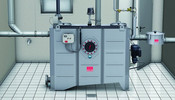Hygienic performance with drainage – II
By: Brett Ira, Key Account Manager for ACO Building Drainage in ACO Czech Republic
Hygienically designed drainage has an important role to play in optimizing hygiene in any food processing environment but how do you ensure it continues to be hygienic and how do you know if it’s performing as well as it should be?
If hygiene is important to your business, it’s not enough to simply install good drainage.You also need to do the following if you are going to successfully mitigate the risk of harmful bacteria living in your drains.
- Clean it properly
The ‘cleanability’ of a drainage system is an often overlooked consideration in the product selection process. For example, sharp corners are harder to clean, particularly if they’re situated at a right angle or bend which means there’s a very real risk that the corner won’t get cleaned effectively. It’s important to ensure every part of the drainage surface is easily accessible to meet best practice guidelines. It’s also important that your drainage be cleaned without power-washing. Power-washing creates ballistic droplets – basically an aerosol spray – which, in minutes, spreads any bacteria that were living in your drainage around the walls, floors and ceilings of your facility! Finally cleaning methodology needs to be considered. Use the right chemicals for the type of factory you are operating and choose hygienically designed cleaning tools. In summary, if you specify a hygienically designed drainage system and you clean, maintain and monitor it on an ongoing basis, you can greatly reduce the risk of bacteria living in your drainage system, optimize the hygienic performance of your food factory and ultimately, keep any risk to public health to a minimum. - Maintain it
By implementing a drainage maintenance program, you can greatly reduce the possibility of microbial build-up and blockage, and ultimately increase the life of your drainage system for years to come. Such programs can be conducted easily on a high performance stainless steel drainage system, especially one which has been hygienically designed so it incorporates, for example, grates which can be lifted without excess effort and internal components, such as silt baskets, foul air traps and foul air trap support rings, which can be easily removed. - Monitor (test) it
Are your drains tested regularly to verify control of listeria and other pathogens? If not, you need to develop a testing regime that is tailored to the needs of your business. The testing of drains at any site should incorporate scheduled checks conducted by your quality assurance department, tests by local food safety authorities and the hiring of an external company to conduct a drainage system assessment within the facility. Drains should also be tested on a frequent basis by internal teams to ensure the hygienic standards of that plant are maintained. Internal teams should also conduct overall drainage assessments on a more frequent basis to reduce the risk of listeria and pathogen build-up and cross contamination.
Drain management programs also help prevent blockages that can result in contaminated water backup and positive air pressure, which, in turn can introduce microbial pathogens into food processing environments. By using CCTV systems to view the inside of the pipes where current build-ups may be or could occur, these types of programs can assess the current state of the drainage and piping system and potentially reduce the risk of positive air pressure.
Other Articles You May Like:
ACO Celebrates Grand Opening of New Facility
Optimizing Hygienic Performance with Drainage Design - Part I
Optimizing Hygienic Performance with Drainage Design - Part II
Hygienic Drain Designs, sanitizers and drain management
Driving the Future of Drainage
Innovations in Stainless Steel Drainage

